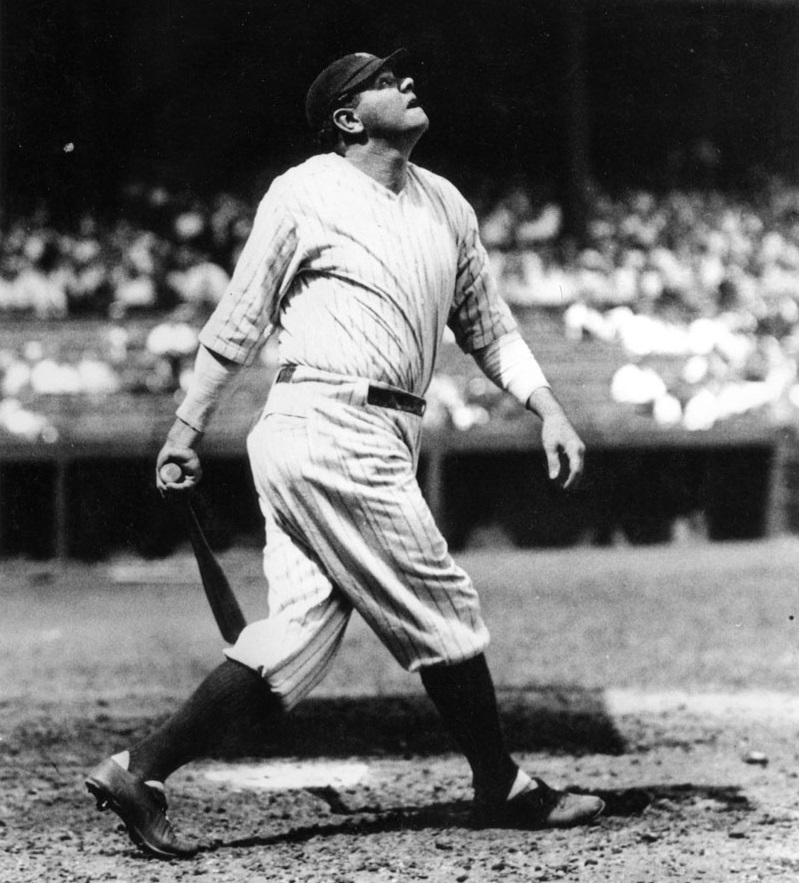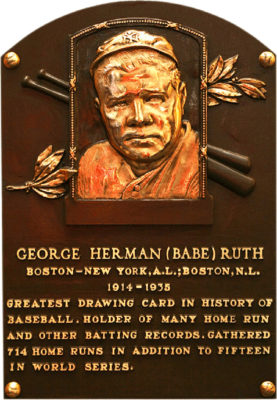
“A Great Man. A Great Ball Player. A Great American.”
So reads the modest, yet succinct plaque to George Herman (“Babe”) Ruth at Yankee Stadium’s legendary Monuments Park.
Who can deny it? From 1921 until his death in 1948, Babe Ruth was America. When Americans saw Ruth, they saw themselves: Kind, generous, fun-loving, boisterous and supremely confident. Ruth never took himself too seriously and neither did America in those innocent, pre-Pearl Harbor days.
Ruth was not always considered the greatest player in baseball history. That honor, from the 1920s onward, went to his great rival, Ty Cobb. In 1936, when the Hall of Fame in Cooperstown had its first official ceremony, it was Cobb, not Ruth, who was the first man inducted. But momentum eventually swung around to Ruth’s side. Only consider Ruth the total ballplayer: He revolutionized baseball with his prodigious home run totals, but he also hit for average. In Ruth’s day, which was still Cobb’s era, a ballplayer was judged by his batting average and what we could call his on-base percentage. Ruth did that, too. Not surprisingly, he drew more than 2,000 walks in his career, but he also hit for average. In 1923, Ruth slugged 41 home runs; he also batted .393. Even the exacting Cobb had to now admit that this Ruth fellow had something going for him. Ruth ended his career with 714 home runs, a number once as well known to every American boy as George Washington’s farewell address. His lifetime batting average was a superlative .342.
 That was only part of the Ruth legend. The Babe came up as a pitcher. Had he stayed at that position, he would have made the Hall of Fame on his hurling prowess alone. While playing for the minor league Baltimore Orioles, the young Ruth was signed by the Boston Red Sox. This young and often temperamental lefty promptly pitched the Bosox to World Series wins in 1916 and 1918, compiling an 89 and 46 record in six solid years on the hill. By then, the World Series was the biggest sporting event in America. As a Yankee, Ruth would dominate, but before that, he made history in the Fall Classic as a southpaw demon, hurling 29 scoreless innings in World Series play. That record stood for 43 years, until Whitey Ford, the ace Yankee lefthander, broke the mark in the 1961 World Series.
That was only part of the Ruth legend. The Babe came up as a pitcher. Had he stayed at that position, he would have made the Hall of Fame on his hurling prowess alone. While playing for the minor league Baltimore Orioles, the young Ruth was signed by the Boston Red Sox. This young and often temperamental lefty promptly pitched the Bosox to World Series wins in 1916 and 1918, compiling an 89 and 46 record in six solid years on the hill. By then, the World Series was the biggest sporting event in America. As a Yankee, Ruth would dominate, but before that, he made history in the Fall Classic as a southpaw demon, hurling 29 scoreless innings in World Series play. That record stood for 43 years, until Whitey Ford, the ace Yankee lefthander, broke the mark in the 1961 World Series.
During his pitching career, Ruth also built a reputation as a star slugger. Pitchers aren’t supposed to hit for average, and so Ruth, as Cobb sagely observed, had the luxury of experimenting at the plate. With a swing he copied from Chicago White Sox slugger “Shoeless Joe” Jackson, Ruth experimented in lifting the ball into the air: Home runs and not necessarily line drive hits would be the focus of the young slugger’s offensive onslaught. It began to pay off: In 1918, Ruth hit 11 home runs while pitching full time; the next year, he hit 29—a league record. Something new was brewing in the game.
In the midst of all this, history came calling. The Red Sox owner, Harry Frazee, had a bust on Broadway with the failed play, “No, No, Nanette.” To compensate, Frazee sold Ruth to the New York Yankees for $100,000. The man and the moment had met. It was 1920. World War I was over. The Roaring ‘20s were set to boom. New York was now the financial and entertainment capital of the world. With mass circulation newspapers and magazines, plus radio and movies, the Age of Celebrity was being born. And who better to fit the bill than this uncouth, but fun-loving manchild? Ruth promptly celebrated his arrival in New York with a jaw-dropping 54 home runs. In 1921, he hit 59. In the next 14 years, the Yankees, led by Ruth and the incomparable Lou Gehrig, would win seven pennants and four World Series titles.
Ruth seemed superhuman, but he was, in fact, a fiercely competitive man. As with other players of his day, he didn’t lift weights (they would cause sprained muscles), but he played hard. “I swing big, with everything I’ve got,” he once told a sportswriter. “I hit big or I miss big. I like to live as big as I can.” The Babe had a gun for an arm. He ran the bases with abandon, his burly frame breaking up double plays and barreling over catchers at home plate. The Babe swung so hard that he occasionally lost balance and fell flat on his face after a particularly hefty cut. And there was his flair for the dramatic, something common to all greats.
The titans of our times—Tom Brady, Joe Montana, Mark Messier, Michael Jordan, Larry Bird—had it, too, but with The Babe it always coincided with an historic event. When Yankee Stadium opened in April 1923, Ruth christened the event with a game-winning home run.
Ten years later, in 1933, the first All-Star game was held in Chicago. A now-aging Ruth welcomed in that annual classic with another game-winning blast. A year earlier, in 1932, saw Ruth’s most famous home run, the “called shot” in that year’s World Series against Chicago Cub hurler, Charlie Root. Was The Babe, with his hand motions, signaling two-strikes (the count on him at the time) to the bench jockeys on the Cubs or was he calling a home run? The latter legend has happily won out.
Finally, in 1927, Ruth came into the last day of the regular season with 59 home runs. You can guess the rest. That day, The Babe parked a fastball by Red Sox pitcher Tom Zachary into the right field bleachers for home run number 60. The world had not seen anything like it. “O Babe! O Socko!” sang the next day’s New York Times headline. Leave it to Babe Ruth to inspire The Gray Old Lady to kick up her heels a little.




















